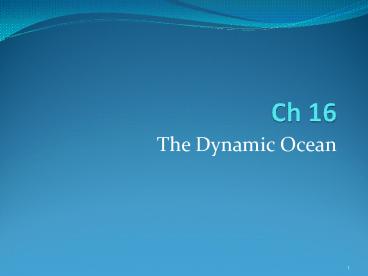Ch 16 PowerPoint PPT Presentation
1 / 12
Title: Ch 16
1
Ch 16
- The Dynamic Ocean
2
Surface Circulation
- Surface Currents
- movements of water that flow horizontally near
the surface - develop from friction between the ocean and the
wind
3
Surface Circulation
- Gyres
- huge circular-moving current systems that
dominate the surfaces of the oceans. - Coriolis effect
- deflection of currents away from their original
course as a result of Earths rotation
4
Ocean Currents and Climate
- Currents from low-latitude regions moving into
higher latitudes transfer heat from warmer to
cooler areas - Upwelling
- rise of cold water from deeper layers to replace
warmer surface water - brings greater concentrations of dissolved
nutrients to the surface
5
Deep Ocean Circulation
- Density currents
- Vertical currents of ocean water that result from
density differences among water masses - Increases in seawater density can be caused by a
decrease in temperature or an increase in salinity
6
Conveyor Belt Model
- Ocean circulation is similar to a conveyor belt
that travels from the Atlantic Ocean, through the
Indian and Pacific Oceans, and back again.
7
Waves
- Most ocean waves obtain their energy and motion
from the wind. - wave height - vertical distance between the
trough and crest. - Wavelength - horizontal distance between two
successive crests or two successive troughs. - wave period - time it takes one full wave to pass
a fixed position. - Fetch - distance that the wind has traveled
across open water.
8
Tides
- Daily changes in the elevation of the ocean
surface - Result from the gravitational attraction exerted
upon Earth by the moon
9
Tides
- Tidal range - difference in height between
successive high and low tides - Spring tides - have the greatest tidal range due
to the alignment of the Earthmoonsun system - Neap tides - have the lowest tidal range,
occurring near the times of the first-quarter and
third-quarter phases of the moon.
10
Forces Acting On The Shoreline
- Waves along the shoreline are constantly eroding,
transporting, and depositing sediment. - Wave Impact
- Abrasion - the sawing and grinding action of rock
fragments in the water - Wave Refraction - the bending of waves
11
Forces Acting On the Shoreline
- Wave Refraction
- Because of refraction, wave energy is
concentrated against the sides and ends of
headlands that project into the water, whereas
wave action is weakened in bays.
12
Forces Acting On The Shoreline
- Longshore Current - a near-shore current that
flows parallel to the shore - Turbulence allows longshore currents to easily
move fine suspended sand and to roll larger sand
and gravel particles along the bottom.

